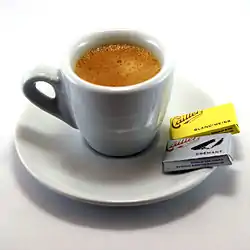 Neapolitans served with a cup of espresso | |
| Type | Chocolate |
|---|---|
| Main ingredients | Chocolate |
Neapolitans (also Napolitains or Naps) are individually wrapped square or rectangular pieces of chocolate in assorted flavours. They are often served by hotels and coffee shops (often with a cup of coffee) and when used for promotional purposes may feature packaging with personalised branding.[1]
Neapolitans are about 3 centimeters (1.2 in) by 2 centimeters (0.79 in) in size, weigh about 5 grams (0.18 oz), and are individually wrapped. They may be of any type of chocolate. Terry's of York, England, first mass-produced neapolitans in 1899.[2] They have since been produced in many flavours by many confectionery companies.
The name "neapolitan" originates from a gift that was made by Louis XVIII in 1819 to Marie-Caroline of Bourbon, a princess from Naples. Each rectangle of chocolate was wrapped individually and featured a view of Naples.[3]
References
- ↑ "Napolitains". E575 (in German). E575 GmbH. Archived from the original on 20 September 2016. Retrieved 16 September 2016.
- ↑ Chrystal, Paul (2013). Chocolate: The British Chocolate Industry. Bloomsbury. p. 52. ISBN 978-0747813132.
- ↑ Tibère, Valentine (2014). 101 chocolats à découvrir. Dunod. p. 75. ISBN 9782100719624.
Ces petits rectangles de chocolat, emballés un par un, furent en effet créés en 1819 pour Marie-Caroline de Bourbon. La princesse, originaire de Naples, les reçut en cadeau de Louis XVIII. Chaqun des chocolats présentait une vue de Naples sur son emballage, d'où leur nom de napolitains. L'effet de mode passé, les rectangles de chocolat tombèrent dan l'oubli.
[These small rectangles of chocolate, wrapped one by one, were indeed created in 1819 for Marie-Caroline de Bourbon. The princess, originally from Naples, received them as a gift from Louis XVIII. Each of the chocolates featured a view of Naples on its wrapper, hence their name Neapolitans. The fashion effect passed, the rectangles of chocolate fell into oblivion.]
- Busch-Stockfisch, Mechthild (2005). Lebensmittel-Lexikon. Behr's Verlag. p. 1265. ISBN 3-89947-165-2.